

Putting the student at the centre of their learning. Share Last week, along with over 60 delegates, 15 speakers and 15 exhibitors, I attended the Jisc RSC HE conference at Manchester University.

The overarching theme was ‘Putting the Student at the Centre of Their Learning’, and I was keen to hear practical examples of how organisations were achieving this through the use of technology. The event opened with a keynote by Professor Mark Stubbs, Head of Learning and Research Technologies from Manchester Metropolitan University (MMU), pictured left. Led by senior managers and embraced by the whole organisation, Mark and his team took on an ambitious project to redesign the undergraduate curriculum to improve the student experience. He spoke of how they ‘wrapped the institution around the learner’ by joining up their systems (including the Virtual Learning Environment, timetabling and coursework submission) into a ‘mega mash-up’ of technology. I particularly liked Dan Peart’s session in the afternoon as he was joined by two of his students. Teaching languages with technology: tools that help students become fluent.
Technology lends itself very well to personalised and independent learning, allowing students to work at their own pace, says Joe Dale.

Photograph: Rosetta Stone Young people live their lives through technology: they are the web generation and they are hungry for more. Our challenge is to channel the natural enthusiasm our pupils have for ICT by using it in their everyday lives and embed it purposefully into the modern foreign languages (MFL) classroom. There is great value in incorporating new technologies not as a bolt on or reward, but as an integral part of the process. This allows learners to foster the four c's: communication, creativity, collaboration and critical thinking.
Publishing students' multimedia outcomes on a blog or wiki gives them a real audience for their work, facilitates peer assessment through commenting and encourages them to raise their standards as a result. Video is another powerful vehicle in and out of the languages classroom. Diigo - Better reading and research with annotation, highlighter, sticky notes, archiving, bookmarking & more.
JISC Inform / Issue 34 / Technology and the student experience. Former NUS president and higher education consultant Aaron Porter considers the topic on everyone’s lips – how to improve the student experience.

In higher education as with life more generally, it’s practically impossible to get by without technology in the 21st century. Whether it is Blackboard, online journals or just a PowerPoint presentation they are the staple of student academic life. It can be easy to pretend that higher education hasn’t changed much in the last few decades, but the increased role of technology has certainly seen a sea-change in the way students engage with their learning and teaching experience.
For the majority of students and staff too, basic digital literacy isn’t a ‘nice to have’, it’s increasingly essential. And for institutions themselves, technology is increasingly being turned to as the solution to longstanding challenges. Academically reform is catching on too. This is backed up when speaking to the current President of NUS, Liam Burns.